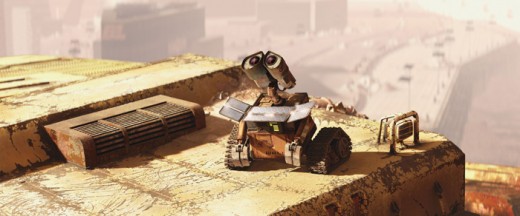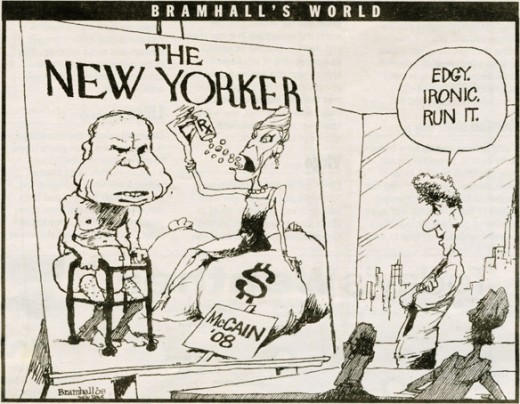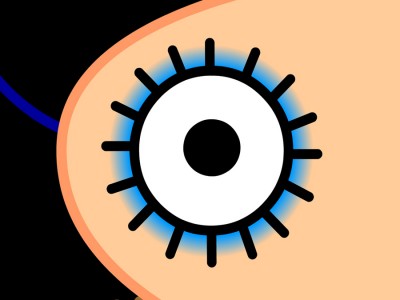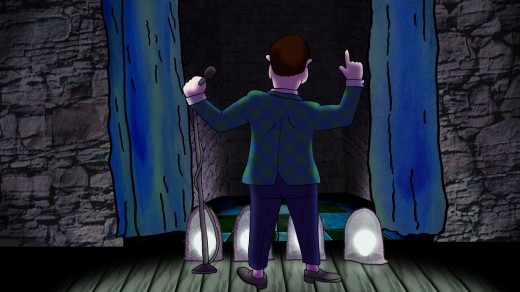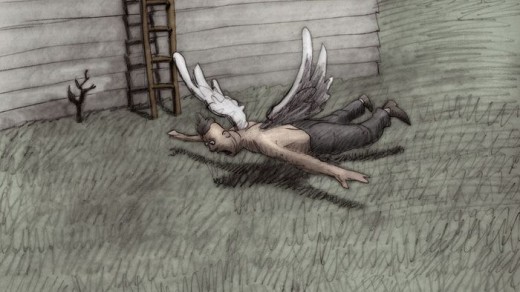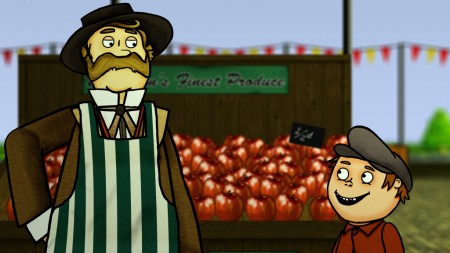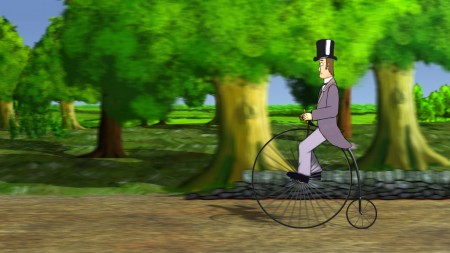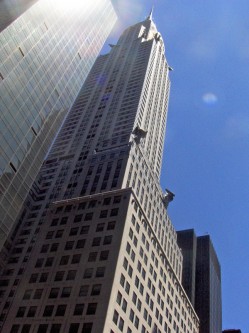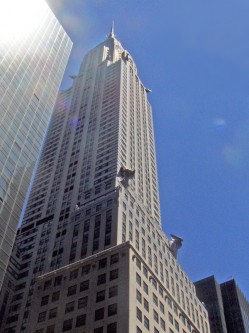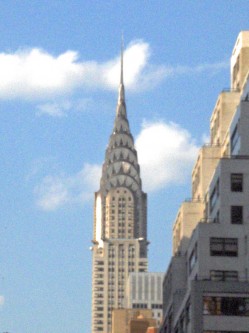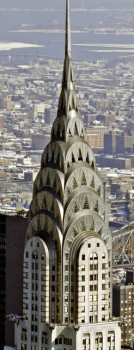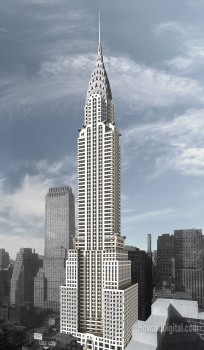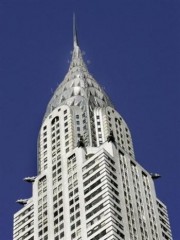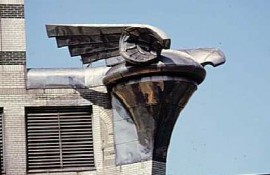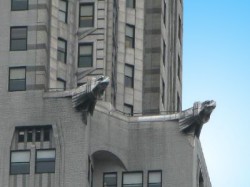Category ArchiveCommentary
Commentary 25 Jul 2008 08:22 am
More on Wall-E
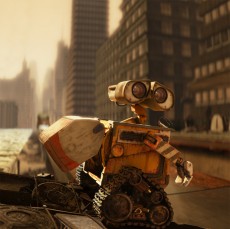 Michael Barrier hit on something with his reviews of Wall-E and Kung Fu Panda. I’ve been thinking about it for quite some time, but I never really plunged into the thought. Two lines of his review stood out for me:
Michael Barrier hit on something with his reviews of Wall-E and Kung Fu Panda. I’ve been thinking about it for quite some time, but I never really plunged into the thought. Two lines of his review stood out for me:
- “The animation of machines is effects animation, and that’s really all we see in the first part of WALL•E.”
“What’s clear from WALL•E and Kung Fu Panda , as never before, is that computer animation is a dead end, a form of puppetry even more limited than stop motion.”
When I first saw Toy Story, I realized that the possibility of computer animation replacing traditional animation might actually exist. Nothing prior to that point led me to think that. What I didn’t expect was that I was watching the high point of the medium.
People concentrated on animating grass (A Bug’s Life), hair (Monsters Inc.), water (Finding Nemo) and, now, machines (Wall-E). Essentially, they were concerned with moving the technical capability of the medium forward and ignored the very real need of moving the characters with any REAL depth. Pixar and Dreamworks gerry-rigged stories around the capabilities of the new medium and animated around those problems. They’ve gotten to the point where they can successfully impersonate the things of real life.
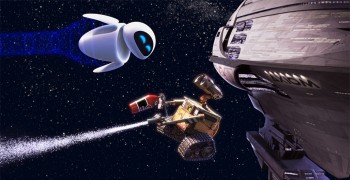 However, if a well rigged commercial can feature computer animation that equals or betters something in Pixar’s best, or a live-action/computer-effx feature (such as Spiderman 2, which has a story almost identical in parts to The Incredibles, or The Dark Knight, which has superior performances to anything in Pixar) works better than the best feature animation scene, what’s the point?
However, if a well rigged commercial can feature computer animation that equals or betters something in Pixar’s best, or a live-action/computer-effx feature (such as Spiderman 2, which has a story almost identical in parts to The Incredibles, or The Dark Knight, which has superior performances to anything in Pixar) works better than the best feature animation scene, what’s the point?
They are animating Special Effects. The animated “Effx” in The Dark Knight are good enough to be invisible as animation. In Spiderman 2 it all looked animated, and I wondered if they were going to try to horn in on the Oscar’s Best Animated Feature category.
Mike Barrier should have gone further in his statement. All computer animation has become Special Effects. Someone moves the skeleton; someone adds the flesh; someone adds textures; someone adds lighting. Who’s responsible? It may as well be a car driving through a rain storm that turns into a desert. Oh wait, was that Cars?
The animation of Kung Fu Panda is closer to what I think animation is, but the movement of the characters has little to do with the actual characters. It’s just fast or slow and derived from the clichés of Kung Fu movies. There’s no character development that the voice over actors haven’t given it. It becomes a lot of little dolls zipping around beautiful backgrounds. Some scenes and animation from Mulan have it all over this feature.
The director is undoubtedly the “auteur” and when you have a Brad Bird who keeps challenging the movement to be more “human” it can work. His films work well, and he seemed to be onto something after The Incredibles. If he ever gets back to animation, perhaps he’ll help advance this medium. At the moment, for me, I don’t see much of a future here. It hasn’t moved beyond Toy Story other than technically speaking.
I’ve seen some recent grumbling about Disney’s Sleeping Beauty, but I think that film was light years beyond anything yet done in computer generated animation. Perhaps, it’s just my own sensibilities and taste boiling over. I’ve watched the Emperor in his new clothes for the past fifteen years. All I’m saying is we’re all getting cold.
The medium is floundering. When you get to see the Honda guy knocking on the glass screen of the TV and are pleased because it’s, at least, animated. No Flash fakery. It’s real animation. It’s alive.
Mark Mayerson has an excellent response to my negative comments on his blog with Babies and Bathwater.
Commentary 19 Jul 2008 08:40 am
Politicks a-plenty
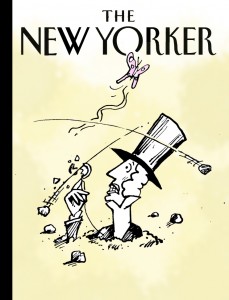 - I’m surprised and a bit pleased that my little piece on the New Yorker cover got such attention. I can’t imagine what slings and arrows the magazine had to face, but I hope it was disastrous for them. They’re the leader in published cartoons, as far as I’m concerned. If the cover of last week’s issue created such problems, I think it probably needed another draft before they published it. We should have understood the perspective of the artist.
- I’m surprised and a bit pleased that my little piece on the New Yorker cover got such attention. I can’t imagine what slings and arrows the magazine had to face, but I hope it was disastrous for them. They’re the leader in published cartoons, as far as I’m concerned. If the cover of last week’s issue created such problems, I think it probably needed another draft before they published it. We should have understood the perspective of the artist.
The little gem to the right is a reworked piece by Tom Hachtman on the subject. (Though I messed it up a bit with some color – it was too white posted here.)
- Joel Stein in the LATimes had a funny piece about how to tell jokes about Obama. There are a couple of good ones in the article (an a couple of
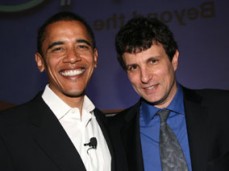 bad ones.)
bad ones.)
- I have to applaud Judith Warner‘s opinion piece in yesterday’s NYTimes. It discusses in length John McCain’s attitude toward women, yet
it doesn’t bring up the many crude remarks, snide jokes, and rude actions that have been attributed to McCain. Check here if you’re interested. This seems to be information that hasn’t gone past the blogs to make it to television, yet Judith Warner has successfully avoided this part of McCain’s actions in her article. __ David Remnick with Barack Obama
Warner simply uses his voting record to back up
the worst. (Note that I admit to having no compunctions about referring to McCain’s crude jokes – past or current.)
I look forward to Frank Rich’s Op-Ed piece tomorrow to see if he broaches the subject. However, I suspect he’ll be writing about the trip to Afghanistan/Iraq etc. It seems to be today’s hot subject.
- Am I the only one who’s had it with Lou Dobbs’ obsession with illegal immigrants. This guy has had a daily hour long show on CNN, and he deals with nothing else but immigration. I live in a city of immigrants – legal and illegal – yet I can’t see that it’s that great a problem. Maybe it is in Lou Dobbsworld. Also, aren’t his teeth a bit TOO white. I think they’d shine in the dark.
- I also have to say that the new Jib Jab cartoon is the first one I’ve liked. Usually, they’re a bit too milquetoast for my taste. A cartoon without a POV is just pointless. In this one they do a bit more than just “jab” everyone. It’s funny. I assume NBC must give them a good part of the budget. They always premiere on the Leno show then receive endless repeats on MSNBC the next day.
Space Chimps had the misfortune of opening against The Dark Knight and Mamma Mia!. Though I like looking at review of animated films, I kinda missed this one. I didn’t know it was opening. Mark Mayerson‘s article clued me in.
- The NY Times, the one glowing review, said: “Space Chimps is hilarious. . . If “Wall-E†pushes the boundaries of what can be done in an animated movie, “Space Chimps†proves that the old formula is still pretty effective when executed well.
The NY Daily News said “Nothing to go ape for.” One star.
Newsday/AP said: “‘Space Chimps” sucks a whole lot of talented people into a wormhole of lousy.” One star.
The NY Post said: “No Ape-peal!” ½ star
Fox, the distributor, obviously was prepared to just dump it on the market. Barry Sonnenfeld is one of the producers; I’m surprised he didn’t have more clout – or didn’t use it.
Commentary &T.Hachtman 17 Jul 2008 08:13 am
The New New Yorker
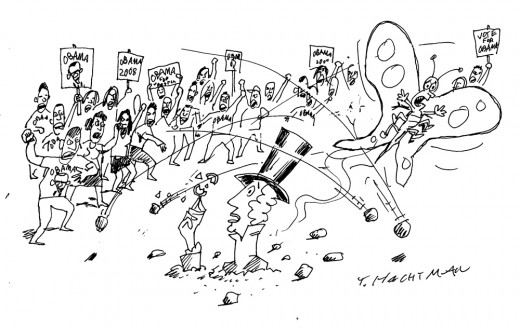
(Click if you want to enlarge any image.)A poignant cartoon by Tom Hachtman that
should be published in The New Yorker, but that
would involve good taste.
_
- I haven’t noticed any animation blogs that are screaming about the New Yorker cover that 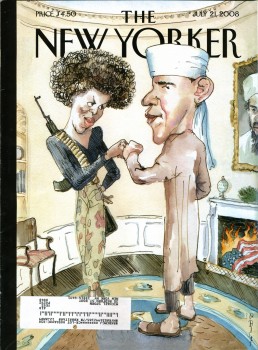 made all the headlines this week.
made all the headlines this week.
(Pictured to the right.)
The thing had me furious when I received my subscription copy this past Monday. I’m an ardent Obama supporter, but the subject matter isn’t what had me irritated. I appreciate a vile caricature as much as the next guy. The best political cartoons are sharp, pointed and acidic. The magazine doesn’t generally post political cartoons on their cover, yet it isn’t the fact that they’ve chosen Obama as their target. I’ve gotten used to it. There aren’t too many left wing magazines posting anti-McCain cartoons, so they may as well attack their own.
What bothered me was the obvious attempt by The New Yorker to be racy, vicious and caustic for the sake of sensationalism. They wanted to sell magazines, so they thought they’d create a stir.
I’ve been a subscriber of the New Yorker for almost 40 years. I’ve read almost all of their issues in that time. This wasn’t the standard they shot for in all those years. Tina Brown came on as editor and tried to shake the magazine up to get subscriptions and ad revenue up. She was replaced by David Remnick, and he seems to want to up the ante. This issue takes the magazine out of the realm of tasteful writing and cartooning. It got vulgar for the sake of sales. This is what they did with that other Condé Nast publication, Vanity Fair. It’s a magazine I dislike enormously.
Now I have to rethink my subscription. OK, I don’t. Within the same magazine is a great article about Obama and the backroom politics that had to be scaled to make it in local Chicago politics. This is the kind of article no one else is writing. Unfortunately, the racist, scurrilous cover is the sort of thing you can find anywhere else.
The edition of the magazine, of course, has just about sold out. Here’s a NY Post article about the business side of the story.
Below is a cartoon I ripped out of The Daily News by Bill Bramhall. It’s hilarious and touches on the “irony” of the situation. Since most of you probably missed it, I thought I’d showcase the cartoon.
- Jeff Scher has a wonderful new animated piece in the NY Times. Fly By Night is a film he’s made by shooting flying bugs and showing their flight paths and motions. I have to admit, I was amazed by it. Go here to watch the 1 min 34 sec film.
- I attended an Academy screening this past Tuesday night. It was the most crowded event of 2008. The place was full. Only one animation member wasn’t there, an oddity in itself. Generally three or four animation folk show up; this time there was even an animation guest, Tom Sito (currently visiting New York).
What was the film? Wall-E? Kung Fu Panda? Space Chimps?
No, it was Mamma Mia! Having seen it, I can testify that it was the most energetic film I’ve seen all year. Meryl Streep doesn’t settle down for one second. She’s all over the place. It had more action than Indiana Jones 4.
Too bad I hated it. It was nice seeing all those people show up, though.
We’ll see if The Dark Knight is as packed next Tuesday.
The Emmy nominations for animation are:
Outstanding Animated Program (for Programming Less Than One Hour)
Creature Comforts America • Don’t Choke To Death, Please
King Of The Hill • Death Picks Cotton
Robot Chicken • Robot Chicken: Star Wars
SpongeBob SquarePants • Inmates of Summer / Two Faces of Squidward
The Simpsons • Eternal Moonshine of the Simpson Mind
Outstanding Animated Program (for Programming One Hour Or More)
Blue Harvest (Family Guy) • FOX • Fuzzy Door Productions in association with Fox Television Animation Studios
Imaginationland (South Park) • Comedy Central
Justice League: The New Frontier •Warner Bros. Animation
Congrats to those nominated.
Articles on Animation &Commentary &Guest writer &Independent Animation 12 Jul 2008 08:23 am
Guest writer: Why Cartoons?
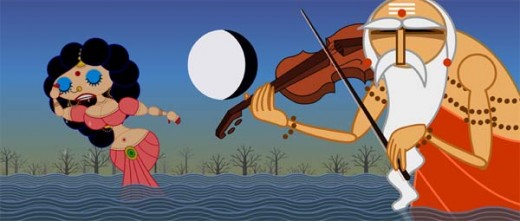 – I received the following article from Nina Paley, the creator/animator/ director/designer of Sita Sings the Blues (which won the Best Feature Prize at Annecy this year.) The article came with a letter, which I think helps explain why she wrote it.
– I received the following article from Nina Paley, the creator/animator/ director/designer of Sita Sings the Blues (which won the Best Feature Prize at Annecy this year.) The article came with a letter, which I think helps explain why she wrote it.
Here’s the letter:
- Hi Michael,
I’m back in NY, finally, spending my first day home in my apartment with the AC on with the cat next to me, surfing the web. I read your review of Wall-E, which I haven’t seen yet, and thought to send you this essay I wrote for Frederator (which they never used) on the theme of “Why Cartoons?”.
Since Berlin, I’ve been convinced that most cinemagoers are simply voyeurs, craving simple stimulation of their primate visual senses in the form of close-up views of beautiful people courting and mating, and gory violence. Things our inner primates think about constantly but seldom get to see. Animation is more abstract and cerebral, visually. I prefer it to live action, but I am a freak (like most animation fans).
Pixar’s success lies in making animation that visually resembles live-action and satisfies the typical cinemagoer’s inner voyeur. Hence the expanding popularity of 3D “animation” among Hollywood producers.
Typical American cinemagoers are put off by 2D animation, but 3D gives them more of what their primate eyes want: to believe they’re watching real events up close without risking personal exposure.
Since I’m going to a lot of festivals with “Sita,” I am struck by the cultural differences between animation festivals and “real” film festivals. When I refer to films as “live-action,” most directors don’t know what I’m talking about; to them live-action is just “film,” and animation is completely off their radars. Most have never heard of Annecy or any other animation festivals. Most film festivals automatically exclude animation from competition, instead programming it in what I call the Animation Ghetto – or worse (in the case of “Sita”), the “Family” or “Children’s” sections. But their programming animation at all is evidence of some progress. And I’m grateful, especially for the 2D animation fans that already exist, and the chance to expose new viewers to the art form.
Hope you’re well,
–Nina
This is the article she sent.
- WHY CARTOONS?
Because less information = more meaning
Animation takes advantage of quirks of human perception. Good cartoons lie somewhere between nature (no abstraction) and text (full abstraction).
At its best, animation does what live action can’t. Good animation is unrealistic. This starts with the style itself: drawings and designs of things that can’t exist in the real world. Exaggerated heads and hands, huge or tiny eyes, rubber-hose limbs, cubism. A handmade line drawing of a robot requires our uniquely human imaginations to understand it as “a robot,” but we may recognize it more quickly than a photograph of a real robot.
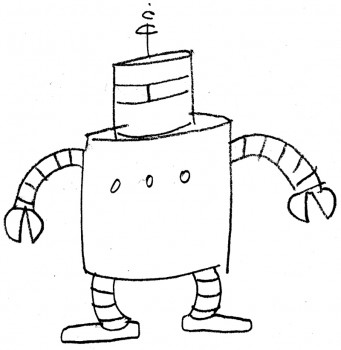
Exhibit A: cartoon drawing of a robot.
Animated motion should also defy reality. For example, bouncy walks that no robot (or human) could replicate, even though we can recognize them as “walks.” Good cartoons stimulate and exercise our imaginations in ways live action never can.
Like reading or working out, viewing cartoons can be exhausting. But far less time is needed to communicate more meaning. That’s why cartoons are so effective as shorts (and commercials).
Live action conveys too much information. “High production values” are the art of removing as much information from nature as possible.
Wrinkles and blemishes on actors’ faces are concealed with makeup; stray threads and hairs are tucked away by stylists; wires and microphones hidden through camouflage, meticulous set design and framing; unwanted details lost in shadows via careful lighting, which heightens only those few areas and outlines intended to convey meaning. But still, excessive information abounds in live action.
Cartoons start with only the information needed. There’s nothing extraneous to hide. If you mean “eyes,” you show a symbolic short-hand representation of “eyes,” nothing more. No gunk in the corner of the eyes, no moles on the eyelids, no eyebrow dandruff – unless you explicitly intend to convey these details as well. The picture is as clear as the idea in the mind of the artist, and that clarity of meaning is transferred to the viewer.
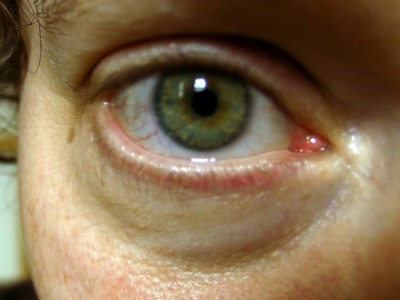
Exhibit C: real eye, belonging to the author.
Notice bloodshot veins indicating stress, wrinkles indicating wisdom and maturity,
shiny skin surface indicating absence of makeup, and other excess information.
(Also, producing animation totally trumps live action: No uppity actors. No obnoxious crew. No permits. No tedious laws of physics. If you can imagine it, you can animate it; no extra charge.)
But animation remains the bastard child of cinema. Most moviegoers just want to watch beautiful people. Bonus if the beautiful people are celebrities; extra bonus if the beautiful people are performing sex or violence onscreen. Animation can deliver meaning, story, ideas – but it doesn’t satisfy the sexual voyeur that drives most cinephiles. In live action, a camera can linger for minutes on a beautiful actress’ face, as the audience attends to all that information: every eye-blink, every change in pupil dilation, the subtlest nostril flare, the slightest movement of any of the hundreds of facial muscles lurking below the makeup. In live action, such a scene is watchable. How could such a serious and pensive scene be conveyed in animation? It would either be painfully dull (a long still) or ridiculous (imagine a Bill Plympton interpretation where every nuance is exaggerated: small nostril flare becomes huge, facial muscle twitch becomes twitchy animal running around under skin) and, like all animation, exhausting.
Live action satisfies our voyeurism, animation ridicules it.
Since I can’t take voyeurism seriously, I go for ridicule.
Animation &Commentary &Independent Animation 11 Jul 2008 08:03 am
John Schnall
- I’d like to talk about a film, but actually it’s not the film but the filmmaker that I’m interested in.
A couple of weeks ago, Mark Mayerson wrote a piece on his blog about Animation and Theater. Mark has become something of an authority on acting and animation. This piece was, in ways, an extension of past comments he’d made about the subject. Having attended a one-man show about Theodore Roosevelt, which was entitled “Bully,” Mark discussed the possibility or the likelihood of animation pulling off such a subject with as much success.
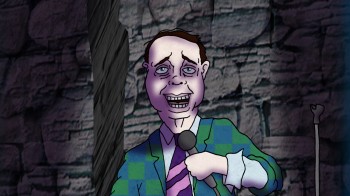 This made me think about the subject that has fascinated me for years. Animating long monologues with any such success. A year or so ago, I’d gone through a number of theatrical monologues thinking I’d have an actor record the piece (or pieces) and try getting them to work. Using animation as a medium to delve beyond the surface to understand character and characterization. One thing leading into another, I never got to complete that project – though I haven’t given up on it.
This made me think about the subject that has fascinated me for years. Animating long monologues with any such success. A year or so ago, I’d gone through a number of theatrical monologues thinking I’d have an actor record the piece (or pieces) and try getting them to work. Using animation as a medium to delve beyond the surface to understand character and characterization. One thing leading into another, I never got to complete that project – though I haven’t given up on it.
Now I find, thanks to a correspondence with John Schnall that he has done this.
John is one of the more daring animators/animation directors out there. He has for years chosen difficult subjects and difficult projects to animate. They all have a strong sense of the bizarre, but they’re all breaking molds that I don’t see others even trying to break.
His most recent film, Dead Comic, is as difficult as it gets. The film is a monologue by a dead comedian, and it offers a gruesome exploration of the afteryears of someone married, eternally to his job. The film could have been called Dead Animator, in my case, but it wouldn’t have been as funny. John has animated a monologue – a difficult monologue.
The film is so difficult that audiences seem to be afraid of it. (Is the subject of death that difficult?) The recent ASIFA-East festival didn’t have the patience even to sit through it, though, in my opinion, it’s better than most of those that won prizes. It’s just more challenging, and the audience wanted more of the expected rather than something complex and difficult.
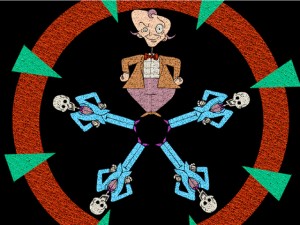 I don’t think it’s the greatest film of all time, but I do think it’s brilliant. You should watch it and understand that the staging is incredibly complex, the timing is very sharp and the design and writing are wholly original and unafraid. it took hard effort, knowledge and ability to make it work.
I don’t think it’s the greatest film of all time, but I do think it’s brilliant. You should watch it and understand that the staging is incredibly complex, the timing is very sharp and the design and writing are wholly original and unafraid. it took hard effort, knowledge and ability to make it work.
In any case, I am always eager to see what John is up to. He’s one of the few artists working in New York and in Independent animation.
Go to John Schnall‘s website here.
See Dead Comic here.
Buy a 40 min. compilation of John’s films here.
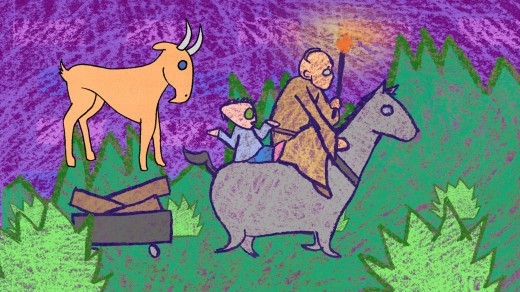
The last two illustrations are from Ha Ha Ha and The Binding of Isaac.
Commentary 06 Jul 2008 08:13 am
more or less – 2
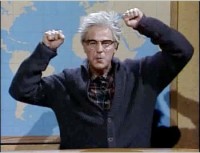 - Dana Carvey, on Saturday Night Live, used to have the “grumpy old man” character. “We had to eat worms, and we liked it!” I’m beginning to feel like the grumpy old man, but I’m hoping I’m saying something here, that touches a nerve in someone else.
- Dana Carvey, on Saturday Night Live, used to have the “grumpy old man” character. “We had to eat worms, and we liked it!” I’m beginning to feel like the grumpy old man, but I’m hoping I’m saying something here, that touches a nerve in someone else.
Yesterday, I was headed in the direction of saying that computer animation in Harry Potter or Lord of the Rings or Indiana Jones 4 was no different to me than the computer animation in Wall-E or, ultimately, Kung Fu Panda. They all move, but, to me, none of them live. The “animus” isn’t there. Artful, well crafted movement is there, but it’s not something that inspires me to go out and draw or get back to my animation box (for the most part, a computer.)
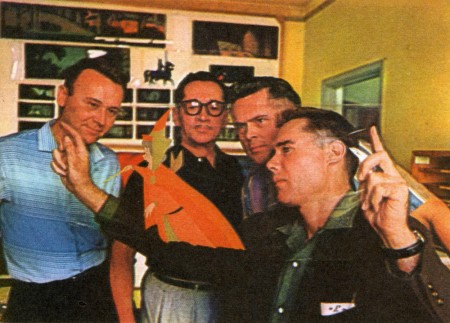 I can remember when just looking at the picture to the right of Eyvind Earle holding up a Sleeping Beauty cel (in Bob Thomas’ book, The Art of Animation) would thrill me to the bone so that I had to start drawing or get myself to the board.
I can remember when just looking at the picture to the right of Eyvind Earle holding up a Sleeping Beauty cel (in Bob Thomas’ book, The Art of Animation) would thrill me to the bone so that I had to start drawing or get myself to the board.
After the release of Beauty and the Beast, John Canemaker and I had a conversation. He pointed out that once he or I would have been taken by a screening of Fantasia or Dumbo and been inspired to animate, and a youngster, today, seeing B and the B would have that same rush. The newer film may not have inspired either of us, but other, younger, future animators were. This was comforting to me.
But recently, when commenting about Wall-E, I wondered if anyone would be inspired by that film. Were there youngsters out there who felt compelled to animate after seeing the Pixar movie? Perhaps through lack of imagination, I can’t see it. But I can’t see it.
Somehow, though, The Iron Giant seemed like something that could inspire people. I also thought The Triplettes of Belleville and Persepolis were inspirational to future animators. I expect the same was true of Toy Story, The Incredibles, even Ratatouille. Perhaps even Kung Fu Panda.
When Don Bluth ran away from Disney and set up his own company to make The Secret of Nimh, there was a lot of excitement in watching their progress. The film wasn’t all we hoped for, but it was light years better than The Black Cauldron.
When Katzenberg left Disney and set up Dreamworks, there was a charge generated, and it was exciting waiting for Prince of Egypt. The film was pretty good, too, and seemed to auger good things for the future of Dreamworks. The announcement of William Steig’s Shrek was a real charge. The horribly ugly film that was produced was so much the loss for computer animation, and that’s when everything changed. Yeah, the grass moved ok, but it was near impossible looking at the damned thing. A sarcastic, sardonic story led the way for nasty films to come. Attitude became everything, and the graphics were lousy.
Animation seems to be diving deep and hard.
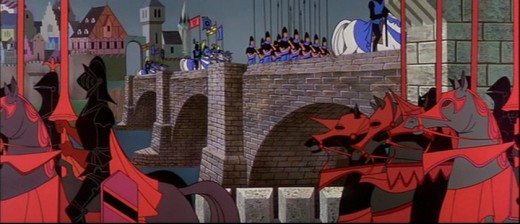
I don’t think it gets more artful than this.
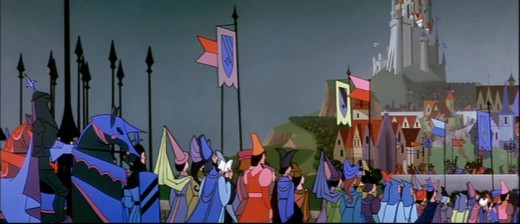
So what’s the answer? We’re in a hole; how do we get out?
It’s all about hope and hard work and not giving up finding that inspiration wherever you can.
A couple of years ago, I was about to throw in the towel. As usual, it was an incessant fight to keep my tiny company afloat. Just paying the rent was sapping my soul from any animation I could pick up. I wasn’t inspired by any of the films I was seeing, and I was beginning to lose hope.
Mike Barrier‘s book, Hollywood Cartoons, arrived just when I needed it, and I soaked it in. The book – especially the writing on Snow White – just charged me like no tomorrow. I finished reading it and started reading it again, immediately. That book saved me, no doubt, and I couldn’t have been more charged. Things turned around for me just by being excited by my medium.
You have to find the book or the film or the charge that’s going to keep you going. Writing this blog helps me, these days. In doing it, I’m always looking into films and frame grabs and endlessly studying animation I love. I can look past films that I think hurt the medium and find something that I love.
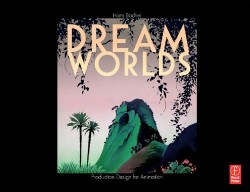 So many books such as Hans Bacher‘s Dream Worlds or Amid Amidi‘s Cartoon Modern offers lots of art; you have to find some inspiration. I’m looking forward to Sylvain Chomet‘s next film, The Illusionist. I want to see Clint Eastwood’s new film, The Changeling. Of course, I can always go to a museum in New York to find art that excites me. And live theater sometimes excites me.
So many books such as Hans Bacher‘s Dream Worlds or Amid Amidi‘s Cartoon Modern offers lots of art; you have to find some inspiration. I’m looking forward to Sylvain Chomet‘s next film, The Illusionist. I want to see Clint Eastwood’s new film, The Changeling. Of course, I can always go to a museum in New York to find art that excites me. And live theater sometimes excites me.
In short there are worlds out there, and I find it up to me to get that inspiration moving. I’ll probably focus on more of those books and films and artworks that inspire me, so this rant just ain’t going to end any time soon.
Sorry.
Commentary 05 Jul 2008 08:33 am
more or less – 1
- Animation has completely done a big turnaround in the past 10 or so years. The medium has evolved so drastically into something else that I’ve come to feel that a lot of the past has become or is getting lost.
Yes, this is going to be one of my usual rants, but I think I have something that’s worth going on about. Maybe a good long conversation can start. I don’t really want to talk about how we got here, but I do want to talk about where we are.
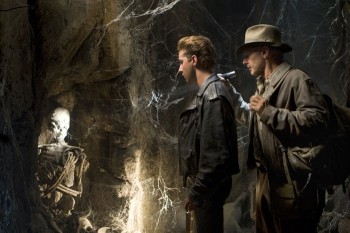 Live action movies aren’t live action anymore. Go to Indiana Jones 4 or Hancock or The Hulk or Journey to the Center of the Earth or most other fare at the local theater, and you maybe get the idea.
Live action movies aren’t live action anymore. Go to Indiana Jones 4 or Hancock or The Hulk or Journey to the Center of the Earth or most other fare at the local theater, and you maybe get the idea.
In 1979, the Museum of Modern Art had a special exhibit complete with chat and Q&A from Peter Ellenshaw.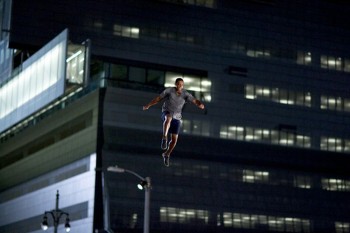
A lot of his matte paintings were displayed, and he talked in front of a projected screening of shots he worked on from many of the films. Mary Poppins, Treasure Island and Polyanna were discussed.
I was struck with how impressionist the paintings were up close, yet on screen they looked so absolutely real. I asked about this, and he said that he found that the paintings had to feel a bit ____________________What’s real?
out of focus to achieve the effect
of reality. When he painted in a very realistic mode, the paintings didn’t work.
His glass paintings, which were painted on glass, originally sat between the camera and the scene. They were designed to add to the background being filmed. Ships in a harbor were painted or a skyline was altered to more closely match the historic film being shot; these were painted on glass and matted out things in reality. These glass mattes eventually were just matted into the scenes optically, though Ellenshaw didn’t change his process.
The paintings were a bit more impressionist than the reality on the screen, but since it was only about a third of the image, we bought it.
 Today these paintings, of course, are painted on computer. Paul Lasaine beautifully details this process on his blog. The matte paintings have, in many films, superceded the reality being photographed. That “impressionism” has come to overwhelm the images we’re watching. When George Lucas talks about having his actors act against a blue screen with all the world being painted in by artists and animators, the film has become something else.
Today these paintings, of course, are painted on computer. Paul Lasaine beautifully details this process on his blog. The matte paintings have, in many films, superceded the reality being photographed. That “impressionism” has come to overwhelm the images we’re watching. When George Lucas talks about having his actors act against a blue screen with all the world being painted in by artists and animators, the film has become something else.
You can see this in the Indiana Jones films. The first had a tactile approach to the effects and the world of Indy. It DID resemble the cheap “B” movie serials it was imitating. Indiana Jones 4 completely lost that with this painted world. There are scenes where the actors are so obviously not in a real world on a real set. They’re acting against a blue screen. The scene in the grave of the aliens, where the 13 skeletons sit above them, is so obviously painted. The actors have no connection to humans in a cave or a grave; they’re not. It’s completely fake and feels it. This is one of the problems with the entire film. There’s no reality; nothing we can touch.
Every film, from Adam Sandler’s Zohan to Get Smart depends too much on the computer and robs the films of interacting humans on screen. They’re not in reality; we can’t buy or accept or understand their situations?
The Harryhausen effects were not real, but the tactile nature of his puppets allowed us, at least, to feel them. To know that something REAL was on the screen. Compare the original Yoda, the Frank Oz voiced puppet, with the digital thing of later films. One felt real, and it wasn’t the digital version of the character. Life for Lucas was made easier, a new animated world opened to him, but the experience for filmgoers was diminished. There was no there there. The real effects of the earlier film allowed us to stay in the film; the fake effects of the new film doesn’t even allow the actors in.
The computer has also changed animation. Obviously, when you have those 13 skeletons animated by computer in Indiana Jones 4, or any of the Harry Potter films or The Hulk,
 and when that looks not too different from the animation from the latest Pixar film, what is the difference? Wall-E‘s reality had nothing to do with me. It was a robot/compacter and another egg shaped robot (that I had even less connection to) interacting. I never entered the film; it had no relation to my life. I watched filmmaking choices, scene cuts and storytelling. I caught all the obvious and pedestrian biblical references, all the intended “depth,” and felt the film go completely haywire once it left what was supposed to be earth. (Why didn’t they just stay on earth and let all the fat humans come to Wall-E so that we could watch them try to rebuild? This is the real story isn’t it? Not the running back and forth throughout the spaceship.)
and when that looks not too different from the animation from the latest Pixar film, what is the difference? Wall-E‘s reality had nothing to do with me. It was a robot/compacter and another egg shaped robot (that I had even less connection to) interacting. I never entered the film; it had no relation to my life. I watched filmmaking choices, scene cuts and storytelling. I caught all the obvious and pedestrian biblical references, all the intended “depth,” and felt the film go completely haywire once it left what was supposed to be earth. (Why didn’t they just stay on earth and let all the fat humans come to Wall-E so that we could watch them try to rebuild? This is the real story isn’t it? Not the running back and forth throughout the spaceship.)
The film felt too connected to all the other films I see on the screen these days, films that I cannot connect to. This is pretty much all I feel for most other computer animated films.
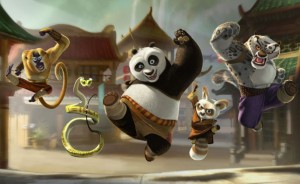 Kung Fu Panda is filled with beautifully drawn and painted backgrounds, much more pleasing than Wall-E. But the little viewmaster-puppet-characters are constantly moving in clichéd poses and actions. (Does every scene have to end with the some character arching their eyebrows?) I know this is a parody of Kung Fu movies, but who cares? What does it have to do with REAL human experience?
Kung Fu Panda is filled with beautifully drawn and painted backgrounds, much more pleasing than Wall-E. But the little viewmaster-puppet-characters are constantly moving in clichéd poses and actions. (Does every scene have to end with the some character arching their eyebrows?) I know this is a parody of Kung Fu movies, but who cares? What does it have to do with REAL human experience?
I also feel that every character moves identically to others. Tex Avery gave us snap animation, and Bob Clampett gave us blurred positions from A to B, but that doesn’t mean every film and every character has to imitate this. (I saw one page on Cartoon Brew from Eric Goldberg‘s new book Crash Course in Animation. It advises young animators to use this blurring technique! Not good advice in my mind. I’ll have to see the book to decide if that’s the norm.)
I haven’t seen Horton yet, but at least that LOOKS different than other computer animated films. The Jim Carrey voice over kept me away, but I’ll watch it eventually. I like some of Blue Sky’s work and still hope for the best.
To be concluded tomorrow.
Commentary 26 Jun 2008 07:51 am
Conflict
- Something tells me this post will get a lot of people angry at me.
There was a bit of a conflict for me on Tuesday night in New York. Bill Plympton screened his film, Idiots and Angels, for much of the animation community here. While Wall-E played at the Academy at 6PM, Plympton’s film started at 4PM. It was a tough hustle to get from one to the other. What was more of a problem for me was having to leave work at 3PM to see Bill’s film. I couldn’t make it work, and I’m sorry I missed it.
I wasn’t as sold on Wall-E as every review I’d read to date. The film, to me, felt less like an animated film than a special effect film.
The story of Wall-E, for those of you who don’t know, is about a robot who has been left on earth (presumably for about 700 years) to try to gather the residue of the planet left behind by the humans. They’ve made earth inhospitable for their own survival. Wall-E is the robot left, with a companion roach, to gather the garbage and compact it into large piles of cubes. He eventually falls in love (robot love) with a more modern robot sent to earth to search for signs of vegetation. Wall-E finds a plant and gives it to her.
Humans have moved to a large spaceship and are treated much too well. They’ve all grown enormously fat not moving from their lounge chairs. The machines are in control, until one human takes charge with the help of Wall-E and brings people back to earth.
Watching the film, it was starting to get claustrophobic while they were on on earth, so I was glad to see them leave. Something had to advance the story. The new world on board the spaceship ends up with robots chasing other robots back and forth, up and down the large ship. It gets awfully tiring, quickly.
The technical abilities are high, and the film is done with the greatest professionalism. But they’re machines being animated, and I never felt close to them. The Iron Giant, from that film, was a hostile, war machine and was supposed to stay a machine, but I felt more for that character than I did for Wall-E or his cutely developed girlfriend, EVE.
 The film has a better concept than story. It’s the bane of all movies these days. If you can narrow the story down to one sentence, it’s more concept than story and has a harder time being successful. Wall-E feels a lot like Short Circuit 3 with no humans – for at least the first half.
The film has a better concept than story. It’s the bane of all movies these days. If you can narrow the story down to one sentence, it’s more concept than story and has a harder time being successful. Wall-E feels a lot like Short Circuit 3 with no humans – for at least the first half.
I was, again, impressed with the incredible artistic abilities of the Pixar people, but I didn’t feel as though I were watching an animated film. It felt like a live action film (until the balloony fat people entered) with high effects. Perhaps that’s a positive; I’m not sure anymore.
Pinocchio, Bambi, Dumbo, Snow White. These films were magic to me as a child. I imagine Wall-E is like every other effects film to today’s children. I can’t imagine it will inspire future generations to get into the field. Maybe, you never know.
I’m sorry I missed Idiots and Angels; I’m sure I’ll see it in Ottawa.
Today’s NY Post gives Wall-E a four star review which ends with, “Some day, there will be college courses devoted to this movie.” The Village Voice‘s glowing review says, “a film that’s both breathtakingly majestic and heartbreakingly intimate.” I can also understand their POV. See it for yourself.
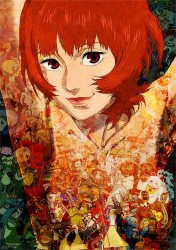
- I wanted to remind those in the New York area that the animated films of Satoshi Kon will be playing at Lincoln Center’s Walter Reade Theater.
The complete retrospective starts tomorrow, Friday, and continues through next Tuesday. Go here to see my recent post including the schedule and other information.
I hope to meet Mr. Kon tomorrow and will report on that this Saturday.
Commentary 25 Jun 2008 08:00 am
A Future
- Lately I’ve been quite bothered by animation, as it currently exists. I’m talking, specifically, about hand-drawn animation. Frame-to-frame drawing.
I don’t include cgi in this, just as I wouldn’t include 3D puppet animation. They’re both different media, to me.
I don’t include Flash films, which to me is a form of cut-out animation. Characters aren’t drawn frame-to-frame, they’re manipulated. (I know, I know, you can use this program to draw frame to frame, but that’s not how it’s used by 99.7 % of those using it.)
I’m talking about drawn animation, frame-to-frame. All of the frames are drawn (not inbetweened by a computer), all of the movement is out of the animator’s hand and head. This is practiced by fewer and fewer artists, and I really worry about the future and trained animators.
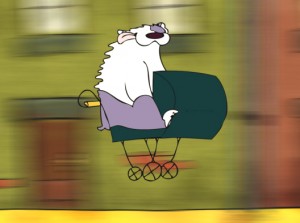 Recently, I received an email from a Scottish student who’d visited my studio back in January ’07. Laura Whyte and Mike Dziennik were in NY and had arranged to meet with me, see the studio and show me their work. Yesterday, she’d sent me a link to the graduation films that the two had done, and I was able to look at other work from the school, Duncan of Jordanstone, the University of Dundee.
Recently, I received an email from a Scottish student who’d visited my studio back in January ’07. Laura Whyte and Mike Dziennik were in NY and had arranged to meet with me, see the studio and show me their work. Yesterday, she’d sent me a link to the graduation films that the two had done, and I was able to look at other work from the school, Duncan of Jordanstone, the University of Dundee.
I have to admit, I was pleasantly surprised. These were students of real animation and real storytelling. Most of the student films from this school were capable and energetic pieces done with some panache. Animation seemed alive.
I suggest you look at the two films of these fine graduate students:
- Chasin’ Tail by L. Whyte, Mairi Steele, Arthur Crook & Shaun Gordon.
Here are Laura’s comments about the film:
Chasin’ Tail was traditionally animated, but we cleaned up in ink and then
vectorised it in Adobe Illustrator.. the backgrounds were designed by a traditional painter and then because there were so many of them, most are digital mockups of her style done in Photoshop. The spinning door is After Effects 3D and the envelopes were done in Maya… and there’s a couple of bits of After Effects animation on the cars and the butterfly in places.
Apple For Sir by Mike Dziennik & Grant Crawford
Laura writes about this film:
Apple for Sir was a much more technical process than Chasin’ Tail… they did all their animation using cut outs in Adobe After Effects, and their backgrounds were 3D environments built in After Effects — they had some epic rendering times, that’s for sure…
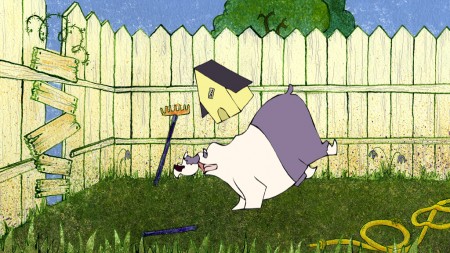
A still from “Catchin’ Tail”
If you want to see other films from this school go here.
Right after seeing these, I saw the link on Cartoon Brew to the Gobelins Animation Gallery. There were Festival openings these students did for Annecy. Here was feature animation quality films done in this extraordinary school. If you haven’t seen them already, go.
I have to say after watching these student films from Scotland and France, I realized that
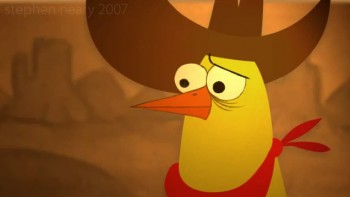 there was hope for hand-drawn animated films. The problem is that I just need to be reminded every so often. I’m sure there are others being done in the US; I just haven’t seen them. There were a couple at the NYU showcase I’d seen that were very promising. (One, Chicken Cowboy by Stephen Neary looked as though it were ready to go ________________Stephen Neary’s “Chicken Cowboy.”
there was hope for hand-drawn animated films. The problem is that I just need to be reminded every so often. I’m sure there are others being done in the US; I just haven’t seen them. There were a couple at the NYU showcase I’d seen that were very promising. (One, Chicken Cowboy by Stephen Neary looked as though it were ready to go ________________Stephen Neary’s “Chicken Cowboy.”
as the pilot for an excellent tv series.)
Then there’s the Rauch brothers’ work, Tim & Mike Rauch; Germans In The Woods was certainly the right track. There is some hope.
I’m looking forward to the Ottawa Festival to get a better gauge on the professional films.
Commentary &Photos 15 Jun 2008 08:43 am
Abu Dhabi Honeymoon
- This week we learned that Abu Dhabi Investment Council has made an $800 million bid to purchase a 75% stake in the Chrysler Building in New York. This iconic building may go out of the hands of American owners and give a Saudi Arabian firm a primary holding in the heart of the city.
Similar events happened in the 1980′s when Japanese investors bought into Rockefeller Center. The feeling back then was doom and gloom as we saw Radio City Music Hall fall out of the hands of local investors. Yet, not too much has really been affected (from the pedestrian’s point of view) as a result of that sale.
Somehow this sale feels a bit personal in that I have an absolute love for this building. I often feel compelled to photograph it for no good reason and have compiled dozens of shots that look identical to all of the other shots I’ve taken of the building. However, this recent news event brought lots of interesting published photos of the site that are particularly interesting. Many of them aerial shots.
There was a period when the film, Bonfires of the Vanities, was in release. That movie centered a lot of its imagery around the Chrysler Building, and it was a bit like heaven. Closeups of those steel gargoyles filled the movie screen as did many other usually unnoticed bits of the building. To me, the second unit photography WAS the show.
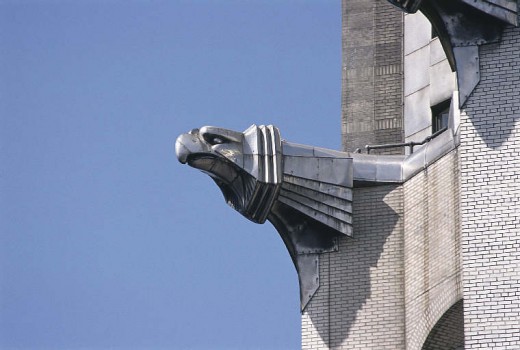
___________(Of course, all photos enlarge by click them.)
